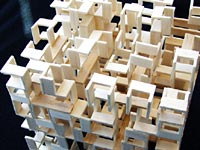|
||||||||||||||||||||||||||||||||||||||||||||
| Architectural History and Theory 5 - ARCH1321 | ||||||||||||||||||||||||||||||||||||||||||||

Description Module 1: Theory: Design and human behaviour. This Module provides an understanding of behaviour-environment theory and its relevance to environmental design and raises questions concerning contemporary values and understandings in architecture. Lectures are presented on elementary behavioural theory, behaviour settings, personal space, territoriality, crowding, privacy, way-finding, place and place-making (genius loci), all of which are examined for their impact on architecture and planning. Aesthetic and functionalist ideas in architecture are cross-related with contemporary notions of meaning, community, identity and polity. Major architectural ideas and design approaches are subjected to scrutiny in light of behaviour-environment research techniques and findings. Material is presented as two-hour lectures supplemented with readings and analyses of selected texts in sociology, psychology, anthropology, environment-behaviour research and architectural theory. Module 2: Theory: Urban theory and practice. This Module deals with architecture and the city, especially as it relates to the nature of the design task. The objective is to bring students attention to our current understanding of urban design and the various roles architects have in shaping the city. Explicit in this analysis will be a redefinition of functionalism in architectural and urban design. Implicit in all designs, if not explicit, is some positive construct of the people imagined as users or participants in the work designed. Questions arise about the adequacy of our definitions and people-constructs, about the degree to which the facts can assist our projections for the future, and on whether our modelling and imaging of life is sufficiently real. Critically evaluating the models we use enhances our creativity because it opens up possibilities that generally fall beyond the scope of our thoughts. Material is presented as two-hour lectures and supplemented by readings in urban theory, town-planning, architectural theory, and people-environment research.
|
||||||||||||||||||||||||||||||||||||||||||||


